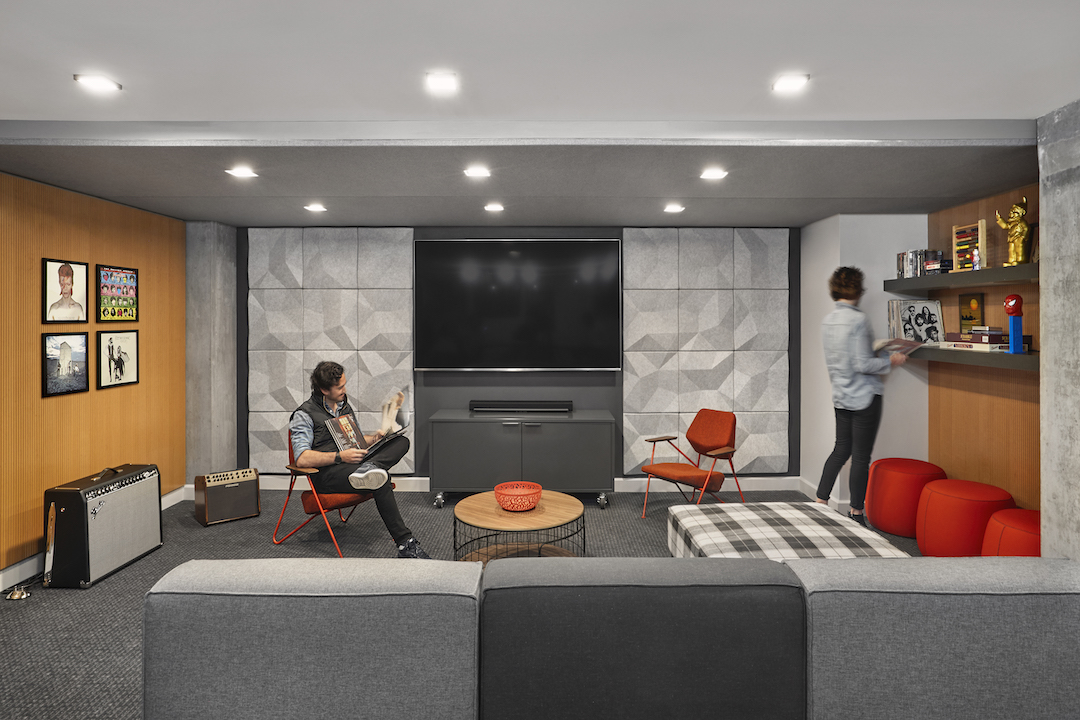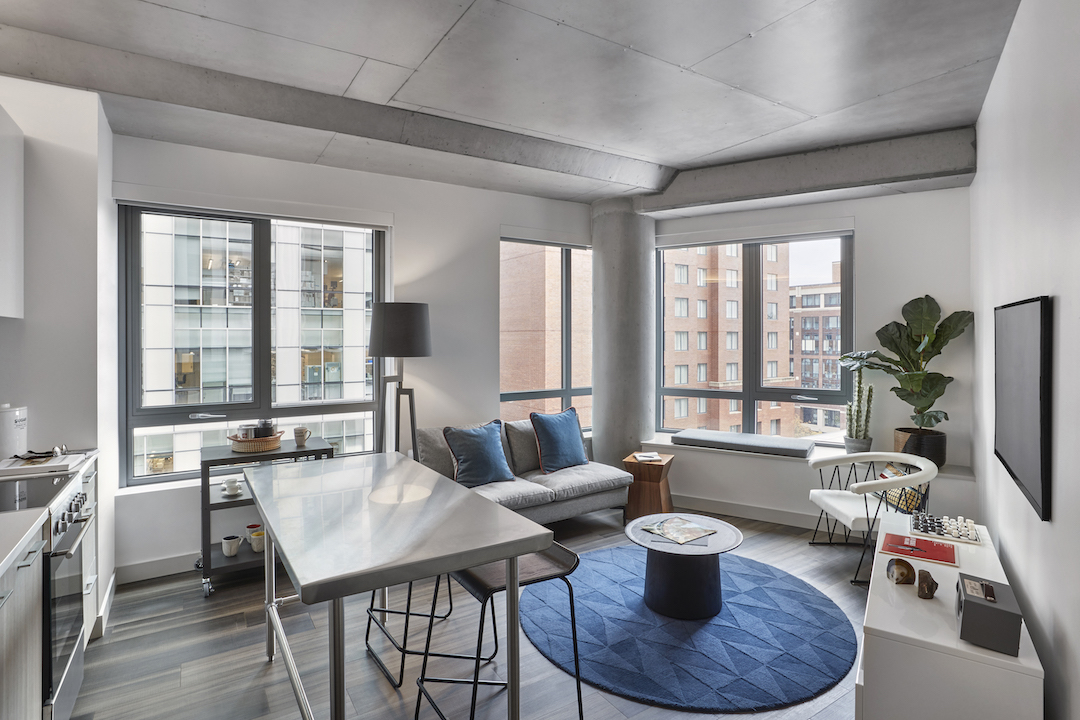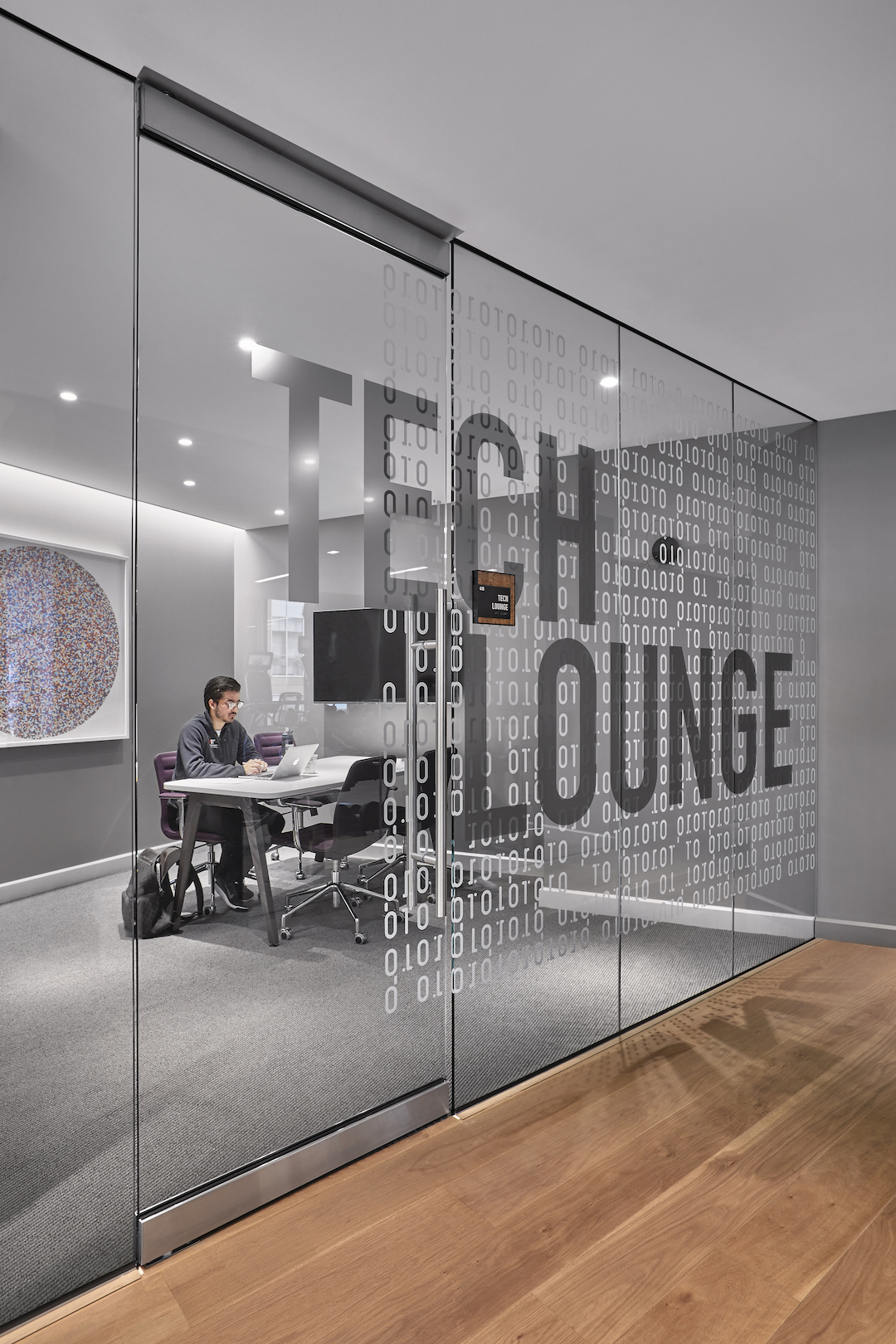A shortage of rental housing in the bustling Kendall Square neighborhood of Cambridge, Mass.—a hub of top-tier universities, research centers, and tech companies—prompted the development of Proto Kendall Square.
Boston Properties commissioned the 22-story, 280-unit apartment tower to help diversify the neighborhood’s office-centric property mix and expand its own multifamily portfolio. “We wanted to demonstrate the value of bringing high-quality rental property to a part of the city where we control a lot of commercial property,” said Boston Properties Project Manager Keir Evans.
Design architect FXCollaborative was tapped to develop the concept for a striking landmark on Ames Street, a minor access road that leads to two parking garages and a loading dock. Located within walking distance of dozens of tech employers and institutions, the site is served by the MBTA Red Line (known as the “Brain Train” for its role in transporting students to and from Harvard and MIT).
 The Garage, a cozy space where residents can hook up an electric guitar, play video games on a big-screen TV, or just kick back and enjoy the kitschy pop culture artwork.
The Garage, a cozy space where residents can hook up an electric guitar, play video games on a big-screen TV, or just kick back and enjoy the kitschy pop culture artwork.
The new structure had to fit within a tight triangular parcel which was formed by razing part of an existing parking garage and narrowing the street to create a bike lane and improve the pedestrian experience.
The goal: “to create a building that had presence, but was respectful of its dense context,” said Gustavo Rodriguez, AIA, LEED AP, Partner and Design Director at FXCollaborative in New York. “We had to strike a delicate balance between providing a sense of openness and a sense of privacy, both for tenants and for the surrounding offices.”
See Also: Eight projects showcase the latest trends in student housing
The design firm specified precast panels and punched windows to give the façade varying levels of transparency at different sections of the structure, informed by the proximity of that section to adjacent office buildings. Larger windows at the corners provide residents with scenic views of the Charles River and Boston skyline. “The building is constantly at play as you move around it, opening and closing to balance privacy and access to natural light and air,” said Rodriguez.
 A typical Proto apartment, 36 of which are classified as affordable. Unit amenities include Nest smart thermostats, ELFA closets, Thermofoil kitchen cabinets, keyless FOB entry, and operable windows.
A typical Proto apartment, 36 of which are classified as affordable. Unit amenities include Nest smart thermostats, ELFA closets, Thermofoil kitchen cabinets, keyless FOB entry, and operable windows.
At ground level, Proto features a modest pass-through lobby and four street-facing retail spaces occupied by a Mediterranean restaurant, coffee shop, florist, and bank.
The mix of the apartments is heavily studio (145 units) and one-bedroom units (90), appealing to the neighborhood’s sizable population of graduate students and millennial STEM workers. There are 43 two-bedroom units and a pair of three-bedroom apartments designed with families in mind. Thirteen percent of the units have been set aside to provide affordable housing.
DESIGNING FOR ‘THE SMARTEST PEOPLE IN THE WORLD’
“Thinking about where the smartest people in the world want to live was a really interesting design challenge,” said Colleen Arria, Principal at Stantec Architecture’s Boston office, which served as architect of record and interior designer. “Because the site was so tight, we had to be incredibly smart about how we planned every square inch of space.”
As you might expect, Proto’s apartments and common spaces integrate high-tech amenities, from smart thermostats to blazing-fast WiFi.
But the design team also created several high-touch amenity spaces that provide opportunities for residents to interact.
 Proto’s third-floor lounge serves as a communal living room for the micro-units on that floor. All residents enjoy 24-hour concierge and ButterflyMX entry system, a dedicated package room with Luxor management system, video gaming systems, a fireside lounge, a communal kitchen, a fitness center, a yoga and spin studio, and a pet spa with dog run.
Proto’s third-floor lounge serves as a communal living room for the micro-units on that floor. All residents enjoy 24-hour concierge and ButterflyMX entry system, a dedicated package room with Luxor management system, video gaming systems, a fireside lounge, a communal kitchen, a fitness center, a yoga and spin studio, and a pet spa with dog run.
The third level houses compact studio apartments and several lounge and co-working areas. It features a unique laundry lounge that doubles as a social space where residents can play board games or watch TV.
The fourth level has a large kitchen that opens to a communal living room area with a ping-pong table and outdoor terrace. Other amenities: a fitness center with a yoga and spin studio, a pet spa, and an adjacent dog run.
The fourth level also offers “The Garage,” a cozy multipurpose space reminiscent of a basement rec room suitable for a replay of “Bill and Ted’s Excellent Adventure.” Initially envisioned as a storage area due to its low ceilings and lack of windows, the space was reconfigured into a casual hideaway where residents could express their creativity.
“As we’ve designed other urban residences for highly educated communities, we’ve found these folks appreciate having a place where they can express themselves—by playing instruments, crafting, or building models—in an environment where they can get messy and not disturb other people,” said Stantec’s Arria.

Throughout the residential community, Proto’s modern, upscale design aesthetic incorporates comfy furniture and an abundance of exposed concrete. Other design elements pay homage to Kendall Square’s rich history—its early connections to NASA, ongoing leadership in the biotech industry, and historic role as a global center of research and innovation. A custom-made rug is emblazoned with excerpts from President John F. Kennedy’s legendary speech on the national role of space exploration.
“The design is really steeped in this idea of science, science fiction, and fantasy—with nods to pop culture icons from Star Wars to David Bowie,” said Timothy Reagen, LEED AP BD+C, Designer/Manager at Stantec. “To us, these elements just resonated with the idea of exploration into the infinite possibilities that science has to offer.”
Built at a cost of $108.7 million, Proto Kendall Square opened in June 2018 and achieved 97% occupancy in its first year of operation.
“It’s garnering the highest per-square-foot rent in the city right now, with a lease renewal rate of over 50%, which is reassuring that the environment that we created is successful and well recieved by residents," said Evans.
Related Stories
| Aug 11, 2010
CityCenter Takes Experience Design To New Heights
It's early June, in Las Vegas, which means it's very hot, and I am coming to the end of a hardhat tour of the $9.2 billion CityCenter development, a tour that began in the air-conditioned comfort of the project's immense sales center just off the famed Las Vegas Strip and ended on a rooftop overlooking the largest privately funded development in the U.
| Aug 11, 2010
Giants 300 Multifamily Report
Multifamily housing starts dropped to 100,000 in April—the lowest level in several decades—due to still-worsening conditions in the apartment market. Nonetheless, the April total is below trend, so starts will move progressively back to a still-depressed 150,000-unit pace by late next year.
| Aug 11, 2010
The softer side of Sears
Built in 1928 as a shining Art Deco beacon for the upper Midwest, the Sears building in Minneapolis—with its 16-story central tower, department store, catalog center, and warehouse—served customers throughout the Twin Cities area for more than 65 years. But as nearby neighborhoods deteriorated and the catalog operation was shut down, by 1994 the once-grand structure was reduced to ...
| Aug 11, 2010
Gold Award: Westin Book Cadillac Hotel & Condominiums Detroit, Mich.
“From eyesore to icon.” That's how Reconstruction Awards judge K. Nam Shiu so concisely described the restoration effort that turned the decimated Book Cadillac Hotel into a modern hotel and condo development. The tallest hotel in the world when it opened in 1924, the 32-story Renaissance Revival structure was revered as a jewel in the then-bustling Motor City.







